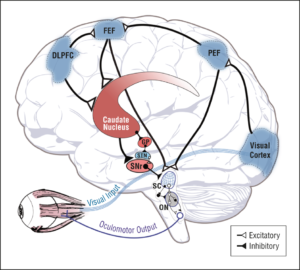The Human Balancing System is made up of 3 basic components.
Our Eyes (Oculomotor System)
Our Inner Ears (Vestibular System)
Our Legs/Muscles (Proprioceptive System)
This series will explore the relationship of these 3 systems and the effects it has on neck and back pain, digestive issues, headaches/migraines, balance, dizziness and vertigo, mTBI/concussion, as well as sports performance and injury recovery.
This write up will cover the Oculomotor System and will be a basic explanation of eye movements. Look for future write ups, videos and blog posts to help explain what is happening in the brain of symptomatic people.
Eye movements are extremely important to our overall health in addition to navigating our world. It not only allows us to see well, but it stabilizes our perception of our world like a blueprint to our brain.
Research has shown that the utilization of eye movements activates multiple  regions throughout the brain. Movement drives brain activation and growth. The coupling of specific eye movements with visual stimulation (colors, patterns, etc.) and specific movements allows us to activate targeted regions of the brain.
regions throughout the brain. Movement drives brain activation and growth. The coupling of specific eye movements with visual stimulation (colors, patterns, etc.) and specific movements allows us to activate targeted regions of the brain.
Types of Eye Movements
(Gaze Holding, Nystagmus, Pursuit, Saccade, Anti-saccade)
Gaze Holding: This function integrates and primes global brain and brainstem pathways; this is a starting point for almost all therapies.
THIS IS VERY IMPORTANT because it is the most basic thing any of us humans can do. Imagine your eyeballs are your smartphone camera and in order to have the target focused on the center of the phones camera, you must keep the phone (your eyes) locked on that target. The areas responsible for controlling this function are mostly located in the brainstem, but can also be influenced by the cortex. When we see the eyes jumping off a target (called square wave jerks or oscillations) we must employ *specific* therapies to address this.
Gaze stability exercises can be as simple as looking at a target straight ahead and shaking your head slowly or quickly, side-to-side or forward-backward in order to exercise those areas responsible for holding gaze. In most cases, physical therapy offices have patient perform this type of exercise, but often time in any chronic condition (listed below) these *basic* exercises are not beneficial because they are not specific enough. We always perform a complete neurological examination to determine gaze stabilization and apply specific therapies for each individual to help improve their neurological function. What sets our office apart from others is paying specific attention to detail and applying those subtleties throughout your rehabilitation.
NOTE: We see unstable gaze holding in many conditions; vertigo, dizziness, post-concussion syndrome, headaches/migraines, neurodegenerative diseases, MS, learning disabilities, neck pain, back pain, shoulder pain, chronic repetitive sports injuries.
Nystagmus- most commonly associated in the media with stroke and BPPV (benign paroxysmal positional vertigo) is a repetitive “twitching” of the eyes in the same direction. However, we see nystagmus almost everyday and it’s not caused by a stroke or BPPV. The problems are due to weakness in certain areas of the brainstem and cerebellum.
Nystagmus moves slowly in one direction then quickly refixates in the opposite direction. The direction of nystagmus is always named based on the direction of the QUICK phase. If it the eye moves slowly leftward, then quickly refixates to the right, this is termed a “Right Beat Nystagmus, or RBN”.
Often we have other practitioners refer us patients with unresolving vertigo even after performing an Eply’s maneuver, where you hang your head off the head of a table and rotate your body around gravity in order to reposition the calcium carbonate crystals within the inner-ear canal. When this maneuver doesn’t work, we must employ specific therapies to address exactly what is going on, and each patient is different.
It is important to address any underlying nystagmus in any individual with dizziness, balance issues, headaches, migraines because it is from a weakness in the cerebellum and central vestibular system. This system is a push-push system, meaning it works in tandem to keep the eyes centered and not off to one side. When you turn your head a signal is sent to the inner ear that activates one side and shuts down the other so your eyes can move in the opposite direction (so it’s now a push-pull system which allows the eyes to move freely).
These are just two components we evaluate in our initial evaluation and we have had great success in stabilizing people eyes so they can see again.
Schedule an appointment 480-756-2600
Next up: Pursuits and Saccades
If you’re having any of the above mentioned symptoms, please make sure to schedule an appointment to evaluate this portion of your neurological system.

